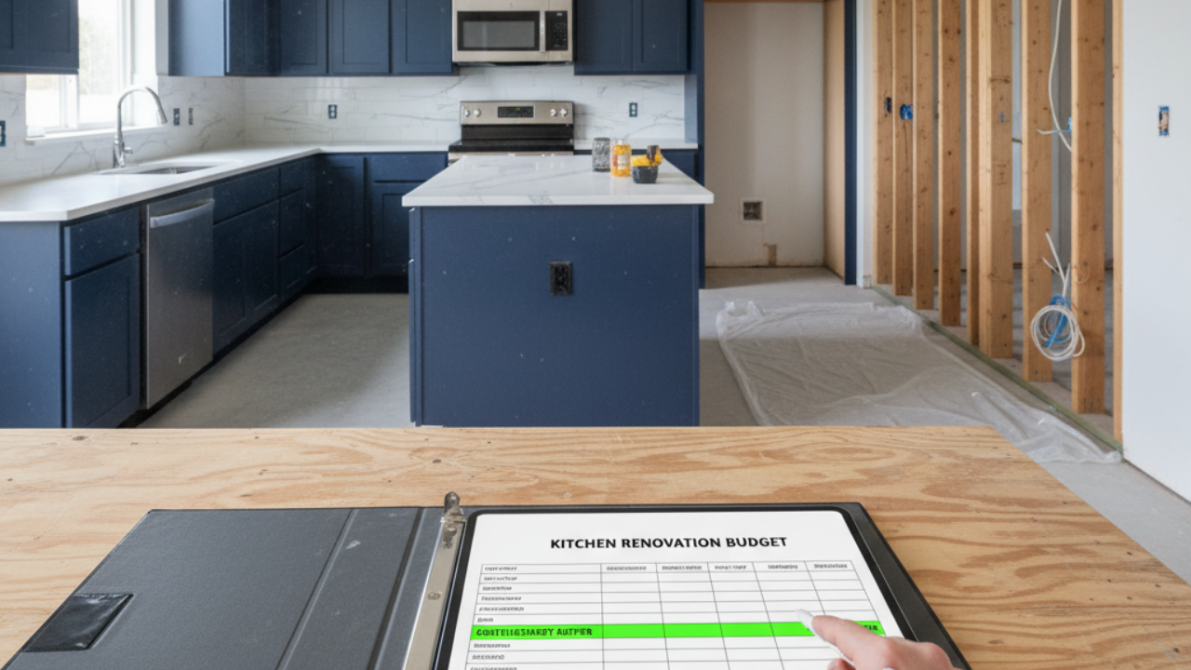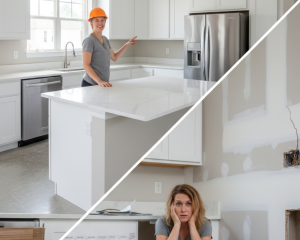How to Budget for a Renovation Without Blowing Costs: The Strategic Property Investor’s Guide
Key Takeaways
- Master renovation budgeting fundamentals: Begin with detailed renovation planning, thorough cost research, and set realistic budgets, including a 10-15% contingency for unexpected expenses.
- Track and control home renovation costs: Use spreadsheets or budgeting apps to monitor spending closely and prevent costly scope creep.
- Prioritise strategic renovation areas: Invest in high-impact spaces—kitchens, bathrooms, and outdoor areas—proven to yield the greatest equity gains.
- Focus on quality and experience: Choose reputable tradespeople and proven renovation systems to avoid budget blowouts from poor workmanship.
Picture this: You’ve found the perfect property with renovation potential. Your mind races with possibilities—a stunning kitchen transformation, a luxurious bathroom upgrade, maybe even that outdoor entertaining area you’ve always dreamed of. But then reality hits. How much will this actually cost? And more importantly, how do you ensure you don’t join the countless property investors who’ve watched their renovation budgets spiral out of control?
If you’re a strategic renovator looking to manufacture equity through smart property improvements, you’re not alone in feeling overwhelmed by the financial complexity of renovations. The fear of overcapitalising and watching your hard-earned money disappear into a renovation black hole keeps many investors awake at night.
The Australian renovation landscape is unforgiving. With kitchen renovations ranging from $20,000 to $130,000, bathroom makeovers costing between $15,000 to $90,000, and countless hidden expenses lurking beneath the surface, it’s no wonder that 78% of renovation projects exceed their original budgets. Yet some investors consistently deliver projects on time and under budget, creating substantial equity gains that accelerate their portfolio growth.
The difference? They follow a proven renovation budgeting system that removes guesswork and provides cost control at every step.
The Foundation: Why Most Renovation Budgets Fail
Many investors approach renovation budgets the wrong way. Rather than establishing what needs to be spent, they start with a preferred figure and try to force the project to fit. The most common mistakes that lead to budget blowouts include:
- Underestimating the true scope of work: Hidden issues such as outdated plumbing add costs you didn’t expect.
- Ignoring the ripple effect on adjoining spaces: Upgraded one space? Suddenly, others look tired too.
- Choosing trades based purely on price: Cheapest is rarely best; poor workmanship leads to do-overs and more expense.
Strategic property investors leverage data-driven frameworks such as those from PropertyChat.ai to avoid these traps.
The Strategic Renovator’s Step-by-Step Budget Framework
Step 1: Detailed Project Planning
Decide whether your renovation will be cosmetic or structural. List project elements in clear categories:
- Demolition and removal
- Structural work
- Electrical and plumbing
- Materials and finishes
- Labour costs
- Permits and inspections
- Contingency sums
Granular planning means costs are less likely to be missed, reducing the risk of budget overruns.
Step 2: Comprehensive Cost Research
- Gather at least three quotes for every major item and trade—this exposes price outliers and ensures market accuracy.
- Consult current renovation cost guides for realistic up-to-date benchmarks.
- Buy materials wisely: Look for end-of-line sales, surplus stock, or local suppliers with proven, reliable options.
Step 3: Setting a Realistic Renovation Budget
- Factor in the full scope: Don’t forget expensive items like moving plumbing or major electrical.
- Always build in a contingency buffer of 10-15%.
- Understand quality tiers: From entry-level to high-end, know what your market expects and budget accordingly.
Budget Control Systems: How to Track and Manage Costs
- Use detailed budget spreadsheets or apps: Record item descriptions, estimated and actual costs, and all variances.
- Monitor all spending weekly to identify and address overruns.
- Guard against scope creep: Any additions to your project must be reviewed for impact—stick to the plan unless there’s a compelling ROI.
High-Return Renovation Priorities
- Focus on kitchens and bathrooms: These consistently offer the best return per dollar spent.
- Outdoor entertaining: Decks and landscaping can dramatically increase perceived property value.
- Invest in what buyers and renters want: Focus on improvements that align with market demand.
Smart Strategies for Saving Money on Renovations
- DIY what you can (safely and legally): Painting, basic landscaping and non-structural demolition can lead to significant savings.
- Buy bulk and time purchases for sales: Stock up on discounted items but avoid waste.
- Use alternative, cost-effective materials where appropriate to control renovation costs.
Managing Trades and Labour Costs
- Choose well-regarded trades with relevant renovation experience over the cheapest options.
- Always get written quotes: Specify inclusions, exclusions, and processes for variations.
- Communicate project boundaries: This prevents well-meaning suggestions that escalate costs.
Mastering Renovation Planning, Timeline, and Project Management
- Create realistic timelines for every phase: Know that kitchens often take 4-6 weeks, not two.
- Build in time contingencies to stay calm (and avoid premium “rush” rates).
- Factor in disruption costs if you’re living on site, such as takeout meals or short-term accommodation.
Learn from PropertyChat.ai’s Proven Frameworks
With over two decades of data on Australian property, PropertyChat.ai offers strategic advantages:
- Up-to-date renovation cost data for your location
- Access to proven, reliable trades
- ROI calculators to assess where your money works hardest
- Early warnings for potential budget blowouts
Leverage these resources to benchmark costs and maximise equity gains from every renovation project.
Common Pitfalls (and How to Avoid Them)
- Cutting corners on critical work: Never skimp on waterproofing or electrical; costs to repair can dwarf initial savings.
- Impulsive add-ons (“while we’re at it” syndrome): Stick to the budgeted scope unless there’s an exceptional business case.
- Overlooking holding costs: Factor in every expense, including loans and lost rent, during the renovation.
Renovation Budget Breakdown Example
Here’s a real-world budget for a mid-range Brisbane kitchen renovation:
- Demolition/disposal: $2,000
- Laminate cabinetry: $12,000
- Laminate benchtops: $3,000
- Appliances: $8,000
- Plumbing: $2,000
- Electrical: $1,500
- Tiling/painting: $3,500
- Labour/project management: $3,000
- Subtotal: $35,000
- Contingency (15%): $5,250
- Total: $40,250
This breakdown ensures clarity at every stage, so you know exactly where your renovation dollars are going.
Long-Term Investment Perspective
Remember, budgeting for renovation is about driving long-term value:
- Assess ROI carefully: Spending should be in line with the value you can realistically add.
- Align the renovation to your exit strategy: Sell, rent, or hold—each has different priorities.
- Adapt to market conditions: In a hot market, higher-end renovations may pay off; in a slower market, focus on stabilising and maximising appeal at the essentials level.
Budgeting for a home renovation without blowing costs requires more than good intentions. By applying systematic planning, real-time tracking, and disciplined execution as outlined above, you can avoid common pitfalls and produce exceptional value from every dollar you invest.
The best property investors lean on proven frameworks, such as those from PropertyChat.ai, to guide their decisions. If you’re ready to start your next renovation project with full confidence, jump into the PropertyChat renovation forums, leverage expert guides, and connect with an investor community that’s focused on building real wealth.
Keen to take your renovation to the next level? Visit PropertyChat Renovation for more expert strategies or start your journey now with the Strategic Renovator’s Guide.
Internal Links to Related Articles
- PropertyChat Renovation Category
- The Strategic Renovator’s Guide: Maximising Property Value
- Best Ways to Finance a Renovation in Australia
- How to Avoid Overcapitalising on Your Renovation
Ready to renovate with confidence?
Start your journey with the proven frameworks and expert support at Your Property Success and PropertyChat.ai.
Transcript
Budget for a Renovation Secrets: Avoid This Costly Mistake
0:00So, you found the perfect place and your
0:02mind is just buzzing with all the
0:04possibilities, right? That gorgeous new
0:06kitchen, that spa bathroom, but then
0:09that little voice kicks in, that big
0:11question, how in the world do you pay
0:13for all this without the budget just
0:14completely spiraling out of control?
0:16Well, stick around cuz that’s exactly
0:18what we’re going to tackle today. And
0:20hey, if that question makes you a little
0:21nervous, you are in very, very good
0:24company. Get this, a staggering 78% of
0:27renovation projects go over budget. I
0:29mean, think about that for a second.
0:30That’s nearly four out of every five.
0:33It’s a huge number. But here’s the good
0:35news. This isn’t just bad luck. It’s a
0:37predictable trap, and it’s one you can
0:39absolutely 100% learn to avoid. Okay,
0:42let’s dive right in. We’ve got a really
0:44clear road map for you today that’s
0:46going to take you from feeling that
0:47financial anxiety to total renovation
0:50confidence. We’ll start by talking about
0:52the renovation money pit. Then, we’ll
0:54figure out why most budgets fail in the
0:57first place. After that, we’ll build a
0:59bulletproof budget framework, learn how
1:01to stay in control, find some smart ways
1:03to get big savings, and then we’ll lock
1:05in your next steps. First up, the
1:08renovation money pit. You know what I’m
1:10talking about. This is all about closing
1:12that massive gap between the dream you
1:14see on Instagram and the cold, hard cash
1:16it actually takes to build it without
1:18any of those nightmare surprises popping
1:20up along the way. So, this is the big
1:23one, isn’t it? How do you avoid that
1:25dreaded renovation black hole where it
1:27feels like your hard-earned money just
1:29vanishes into thin air? Well, the
1:31answer, and really the key to your
1:33success, starts with understanding
1:35exactly where things usually go wrong.
1:37You know what’s really fascinating is
1:39that most budget blowouts, they’re not
1:42random. It’s not just bad luck. They are
1:45completely predictable and they almost
1:47always come from just a handful of
1:49common mistakes people make right at the
1:51very beginning. And this right here,
1:54this illustrates the core mindset shift
1:56you’ve got to make. The wrong approach
1:58is picking a number you want to spend
2:00and then trying to shoehorn the project
2:02into that box. The strategic approach,
2:04it’s the complete opposite. You start by
2:07figuring out what the project really
2:08costs based on actual research and then
2:11you build your budget from the ground
2:12up. So, let’s talk about these common
2:15budget killers. First up,
2:17underestimating the true scope. This
2:19happens all the time. You open up a wall
2:21and surprise, you find a whole mess of
2:24old wiring that has to be replaced.
2:26Second, ignoring the ripple effect. You
2:28know, you build this amazing new kitchen
2:30and suddenly the dining room next to it
2:32looks old and tired and now that’s on
2:34the list. And third, and this is a big
2:36one, choosing your trades people based
2:38only on price. Going for the cheapest
2:40quote often means you end up paying
2:42twice. Once for the bad job and a second
2:44time to get it fixed properly. All
2:47right, enough with the problems. Let’s
2:49get to the solution. This is what I call
2:51the bulletproof budget framework. And
2:53let me tell you, this is what separates
2:55the smooth, successful projects from all
2:58those stressful horror stories you hear
3:00about. It’s a really simple but
3:02incredibly powerful three-step process.
3:04Step one is detailed project planning.
3:07And when I say detailed, I mean
3:09granular. We’re talking everything from
3:10demolition permits down to the specific
3:12model of cabinet handles you want. Step
3:15two, comprehensive cost research. This
3:17means getting at least three quotes for
3:19every single major job. It’s not about
3:21finding the cheapest. It’s about
3:22understanding the true market rate for
3:24the work. And finally, step three, set a
3:27realistic budget. You take all that data
3:29you’ve gathered and you build your
3:30number. No more guesswork, just facts.
3:33Now, if you only remember one thing from
3:35this whole explainer, please make it
3:37this. After you have your total cost,
3:39you absolutely must add a 10 to 15%
3:43contingency buffer. And you have to
3:45treat this like a real cost. It is not
3:47extra money. It’s your project’s
3:49built-in insurance policy for the
3:50unexpected. And trust me, it is
3:52completely non-negotiable. Let’s make
3:54this super real with an example. Check
3:56out this budget for a mid-range kitchen
3:58Reno. See how everything is broken down
3:59from demolition all the way to labor.
4:01The subtotal is $35,000. Now, an amateur
4:04stops right there, but a pro knows the
4:06real budget isn’t 35K. It’s $40,250
4:10because that critical 15% contingency is
4:12already built in. That’s your real
4:14number. Look, having a rock-solid budget
4:16is amazing, but it’s only half the
4:18battle. A plan is pretty much useless if
4:21you don’t actually stick to it. So, now
4:23we need to talk about how you stay in
4:24control once the dust starts flying and
4:26the hammers start swinging. And to stay
4:28in control, you’ve got to know your
4:30number one enemy. Its name is scope
4:32creep. It’s this sneaky process where
4:34your project just slowly grows and
4:36changes, one little add-on at a time,
4:39until suddenly you’ve blown way past
4:40your original plan, and you guessed it,
4:42your budget. And it almost always begins
4:45with five simple, incredibly dangerous
4:48words. While we’re at it, hey, while
4:50we’re at it, let’s just replace that
4:52other window. You know, while we’re at
4:53it, we might as well redo the floors in
4:55the hallway, too. Each one sounds
4:57totally reasonable on its own, but
4:59believe me, together, they are absolute
5:01budget assassins. So, what’s your
5:03defense system? It’s simple, but it’s
5:05powerful. First, you need a detailed
5:08spreadsheet or an app to track every
5:09single dollar coming in and going out.
5:11Second, you have to watch it like a hawk
5:13at least every week so you can spot
5:15problems early. And third, you have to
5:17be disciplined. Stick to the plan unless
5:19a change offers a seriously compelling
5:21return on your investment. No emotional
5:23in the- moment decisions. Okay, now for
5:26the fun stuff. Let’s talk smart wins and
5:28big savings. Because having a great
5:30budget isn’t about being cheap. It’s
5:32about being strategic. It’s about
5:34knowing exactly where to spend your
5:35money for the biggest impact and where
5:37you can find some clever savings along
5:39the way. The data on this is crystal
5:41clear. Not all renovation dollars are
5:43created equal. If you want the biggest
5:45bang for your buck, the highest return
5:47on investment if you ever decide to
5:49sell, you pour your money into these
5:51three areas: kitchens, bathrooms, and
5:53outdoor spaces. This is where your
5:55investment really, really works for you.
5:58And on the other side of the coin, how
6:00can you save some money without
6:02sacrificing quality? Well, first, DIY
6:04the stuff you can safely handle. We’re
6:06talking painting, maybe some basic
6:08landscaping, but please leave the
6:10electrical and plumbing to the pros.
6:12Second, time your big purchases. You can
6:14save a ton by buying appliances during
6:16seasonal or end of financial year sales.
6:18And third, look into smart material
6:20alternatives. Sometimes a really
6:22high-quality laminate can give you that
6:24beautiful hardwood look for a fraction
6:25of the price. Okay, let’s bring this all
6:29home. We started out with that feeling
6:30of dread and anxiety about the costs,
6:33but now you have the framework.
6:34Following these steps is what takes you
6:36from that uncertainty to a place of
6:38confident datadriven planning and
6:40ultimately to a successful onbudget
6:43renovation.
6:44So when you boil it all down, the
6:46formula for success is right here. It’s
6:48data plus discipline plus planning.
6:51That’s really it. It’s not magic. It’s
6:53just a process. If you can master these
6:55three things, you’re not just crossing
6:57your fingers and hoping for the best.
6:58You are engineering a great result. So,
7:01I guess the final question is, are you
7:03ready to stop worrying and start
7:05renovating with real confidence? If you
7:07want to put this entire framework into
7:09action with some incredible datadriven
7:10tools, ROI calculators, and get guidance
7:13from a whole community of people who’ve
7:15been there and done that, then your next
7:17step is simple. Head on over to
7:18propertychad.ai.
Frequently Asked Questions
What percentage of my property value should I spend on renovation?
Spending no more than 10% of your property’s current value is a solid guide, but always analyse your local market, the property’s condition, and intended outcome. Use PropertyChat.ai tools for tailored ROI analysis.
How do I manage unexpected renovation costs?
How do I manage unexpected renovation costs?
Always include a 10-15% contingency in your renovation budget. When things crop up, prioritise essentials and reassess desirables for ROI before adding to your spend.
Is it worth hiring a project manager for my renovation?
For complex or high-value renovations (over $50,000), a project manager often offers cost savings through efficiency, network access, and avoiding major mistakes. Expect to pay 5-10% of project costs.
What’s the biggest budgeting mistake for first-time renovators?
Not considering the knock-on effect—updating one area often means others need work too. Plan holistically to avoid scope creep blowing your renovation budget out.



